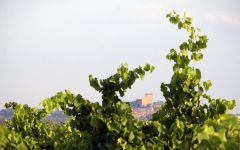Domaine de Marcoux Chateauneuf-du-Pape Vieilles Vignes 2016
-
Jeb
Dunnuck -
Robert
Parker - Decanter



Product Details
Your Rating
Somm Note
Winemaker Notes
Professional Ratings
-
Jeb Dunnuck
Bottled end of March (like the traditional cuvée), the 2016 Châteauneuf-du-Pape Vieilles Vignes comes from just two terroirs -- Charbonnière and Esquierons -- since they no longer use grapes from Galimardes, as it was recently replanted due to disease. The wine was completely destemmed and brought up all in concrete tanks. This rocking effort is still a baby in terms of evolution but still gives up a huge bouquet of kirsch, strawberries Asian spices, candle wax, white flowers, and graphite. Deep, rich, and powerful, yet with the hallmark elegance of the estate, it has fine tannin, an awesome mid-palate, incredible purity and a huge finish. It's another great, great vintage for this cuvée that readers shouldn't miss.
-
Robert Parker's Wine Advocate
The 2016 Chateauneuf du Pape Vieilles Vignes was matured entirely in concrete. It boasts lovely red plum-scented fruit and a broad mix of spices on the nose, followed by a full-bodied, supple, rich palate that hints at blueberries and licorice on the long, velvety finish. Although I didn't detect any heat in these wines, I'd be cautious of aging them too long; once the fruit fades, the alcohol may become much more apparent.
Range: 95-97 -
Decanter
Fermented and aged in concrete for 18 months, this has lovely strawberry Grenache fruit on the nose, with a hint of cherry blossom. Sweet strawberry and raspberry on the palate teams up with bright acidity that helps to counter the sweet fruits. It's full but not heavy, with remarkable energy, and ample tannins which give texture, length and support to the ebullient fruits. A long finish. Certified organic. Drinking Window 2020 - 2033
Other Vintages
2020-
Robert
Parker - Vinous
-
Jeb
Dunnuck -
Wine
Spectator
-
Jeb
Dunnuck -
Wine
Enthusiast -
Wine
Spectator -
Robert
Parker - Decanter
-
James
Suckling -
Wine &
Spirits
-
Jeb
Dunnuck -
Robert
Parker
-
Jeb
Dunnuck -
Robert
Parker
-
Wine
Spectator -
Robert
Parker
-
Robert
Parker -
Jeb
Dunnuck -
Wine
Spectator
-
Robert
Parker
-
Robert
Parker
-
Robert
Parker -
Wine
Spectator
-
Robert
Parker
-
Wine
Spectator -
Robert
Parker





In 1990, the Domaine became the first in the Chateauneuf-du-Pape to implement biodynamic farming practices. Their youngest vines are 40 to 60-years-old, and in short, the sisters do as little as possible to the harvested grapes. This domaine, as critic Stephen Tanzer put it, is "the essence of Chateauneuf-du-Pape."
In 2003, Robert Parker named Sophie and Catherine on his list of "Wine Personalities of Year," writing, "Over the last 12 years, the biodynamically farmed vineyard has risen to the top of Chateauneuf-du-Pape's quality hierarchy. The two red wines produced have been stunning, with the regular cuvée of Chateauneuf-du-Pape one of the finest in the appellation, and the limited production Cuvée Vieilles Vignes one of the world’s truly magnificent wines."

With bold fruit flavors and accents of sweet spice, Grenache, Syrah and Mourvèdre form the base of the classic Rhône Red Blend, while Carignan, Cinsault and Counoise often come in to play. Though they originated from France’s southern Rhône Valley, with some creative interpretation, Rhône blends have also become popular in other countries. Somm Secret—Putting their own local spin on the Rhône Red Blend, those from Priorat often include Merlot and Cabernet Sauvignon. In California, it is not uncommon to see Petite Sirah make an appearance.

Famous for its full-bodied, seductive and spicy reds with flavor and aroma characteristics reminiscent of black cherry, baked raspberry, garrigue, olive tapenade, lavender and baking spice, Châteauneuf-du-Pape is the leading sub-appellation of the southern Rhône River Valley. Large pebbles resembling river rocks, called "galets" in French, dominate most of the terrain. The stones hold heat and reflect it back up to the low-lying gobelet-trained vines. Though the galets are typical, they are not prominent in every vineyard. Chateau Rayas is the most obvious deviation with very sandy soil.
According to law, eighteen grape varieties are allowed in Châteauneuf-du-Pape and most wines are blends of some mix of these. For reds, Grenache is the star player with Mourvedre and Syrah coming typically second. Others used include Cinsault, Counoise and occasionally Muscardin, Vaccarèse, Picquepoul Noir and Terret Noir.
Only about 6-7% of wine from Châteauneuf-du-Pape is white wine. Blends and single-varietal bottlings are typically based on the soft and floral Grenache Blanc but Clairette, Bourboulenc and Roussanne are grown with some significance.
The wine of Chateauneuf-du-Pape takes its name from the relocation of the papal court to Avignon. The lore says that after moving in 1309, Pope Clément V (after whom Chateau Pape-Clément in Pessac-Léognan is named) ordered that vines were planted. But it was actually his successor, John XXII, who established the vineyards. The name however, Chateauneuf-du-Pape, translated as "the pope's new castle," didn’t really stick until the 19th century.
